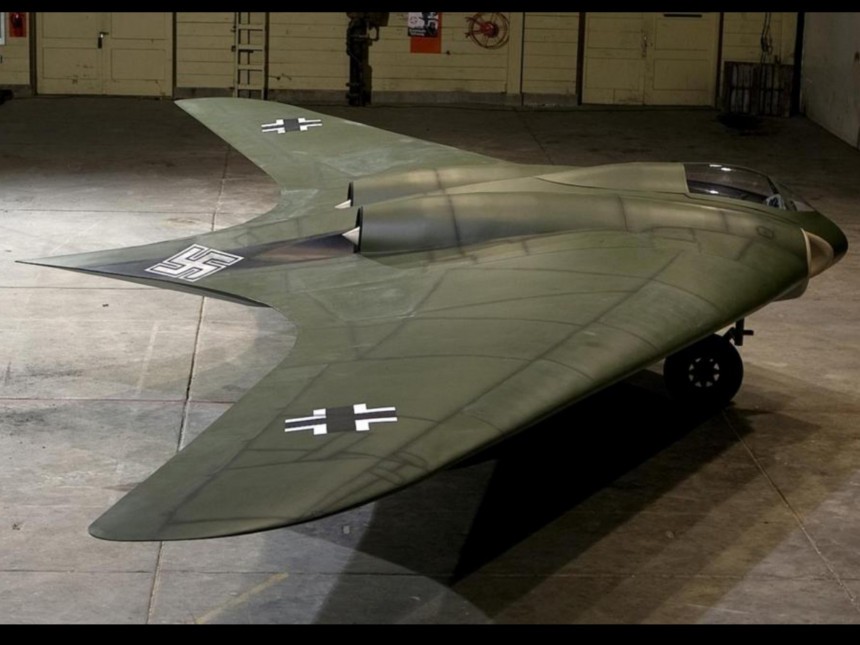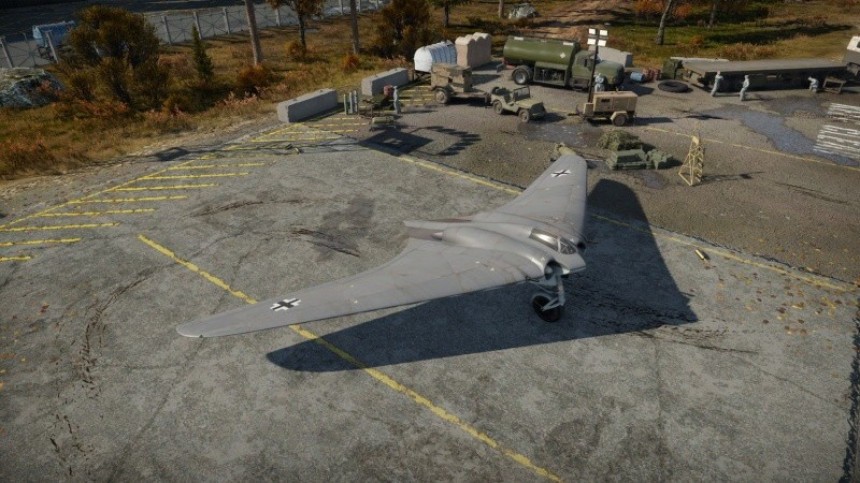There's more than a little bit of misinformation out there when it comes to World War II-era German scientists and their supposedly out-of-this-world exploits. Everything from Nazi UFOs to a levitating, time-traveling monstrosity supposedly called Die Glocke (The Bell).
But of all the layers upon layers of bogus claims attributed to German science during the war, one pervasive theory continues to make its rounds around the internet as if it were genuine fact. The subject in question? That would be the Horton Ho-229, the flying wing German jet fighter that, at the very least, was once hell of a cool design. It's also fun as heck to fly in War Thunder, to boot.
But what really grinds our gears more than anything when it comes to the Horton 229 is the fact that in 2022, people still refer to it as "a Nazi Stealth Bomber." Now, there are more than a few reasons why the untrained eye would immediately conflate the radical, flying wing design of the Ho-229 with modern stealth bombers using a similar layout. You know, the B-2 Spirit, B-21 Raider, and so forth.
But is there even a tiny iota of truth behind any of these claims? Was the Horton 229 legitimately a stealth aircraft? Well, the short answer is no. The B-2 Spirit has its spiritual roots in the Northrop YB-39 and YB-49 flying wing strategic bomber prototypes from the late 1940s through the early 50s. Even so, the long answer is also pretty darn interesting.
Now, before we get into it, a special shoutout to LazerPig on YouTube, whose long-form video essay on this matter was instrumental in gathering information for this little exposé. The facts LP presented seem to all check out as well. Go check out his channel and subscribe if you want to learn more.
But in any case, the Horton 229 was less of a triumphant achievement of German engineering and more of a case of throwing you-know-what at the wall and seeing what stuck as the war on both the Eastern and Western front started to turn south rapidly for the German Luftwaffe. An organization headed by a rotund, drug-addicted lunatic named Hermann Göring.
It was Göring, with Hitler's blessing, who signed off on much of the radical and technologically advanced German military projects of the war. Things like the Me-262 jet fighter and the V1/V2 missile projects were just a handful that actually managed to get off the ground.
But when Hermann Göring was presented with plans from brothers Walter and Reimar Horton, he was more than interested. The two had been prolific glider designers before the war, part of a larger obsession with soaring post-World War I.
It was indeed through soaring that the unpowered glider prototype for the Ho-229 was created, dubbed the H-9. Had the war over Europe not ended, it was thought hoards of 229s could fly faster, higher, and pack a meaner punch of ordinance than any Allied plane.
Perhaps as fast as 960 km/h (600 mph) by some estimates. But with this in mind, it's been said that the Horten Brothers deliberately overstated the abilities of the Ho-229 in an attempt to keep their cushy engineering jobs and stay off the meat grinder that was the Eastern Front.
After the war, Reimar, the younger of the two Horton Brothers, attempted to sell his design to the Chinese of all places. It's while pitching his idea to a Chinese government in a state of active collapse that Reimar is purported to have claimed the 229's primitive radar absorbant coating could defeat British radar systems, essentially making a stealth aircraft. Whether that was actually true or not was somewhat up for debate in the years that followed.
That was until engineers at Northrop Grumman, the eventual builders of the legitimate stealth bomber, the B-2 Spirit, decided to test Horton's claims in the immediate fanfare following the public unveiling of the B-2. The only trouble was that no one at Northrop Grumman had even heard of the thing. This prompted a handful of the team to fashion a one-to-one scale copy of the 229 out of wood.
When they ran the test dummy through the same radar simulations they'd just used to design the iconic B-2 Spirit, Northrop Grumman found Horton's claim that the thing is a steal bomber to be a complete load of malarkey. If anything, the all-wooden construction of the test article turned out to be even less of a radar signature than the all-metal Ho-229 would have had. This replica is now in the collection of the San Diego Air & Space Museum in California.
But despite all of this, the rumor persists that the B-2 and its successor, the B-21 Raider, both trace their roots back to the Horton Brother's design. A radical and groundbreaking airplane it may have been. But a stealth bomber? We think not. So let's take this opportunity right here, right now, to put this rumor to bed for good.
But what really grinds our gears more than anything when it comes to the Horton 229 is the fact that in 2022, people still refer to it as "a Nazi Stealth Bomber." Now, there are more than a few reasons why the untrained eye would immediately conflate the radical, flying wing design of the Ho-229 with modern stealth bombers using a similar layout. You know, the B-2 Spirit, B-21 Raider, and so forth.
But is there even a tiny iota of truth behind any of these claims? Was the Horton 229 legitimately a stealth aircraft? Well, the short answer is no. The B-2 Spirit has its spiritual roots in the Northrop YB-39 and YB-49 flying wing strategic bomber prototypes from the late 1940s through the early 50s. Even so, the long answer is also pretty darn interesting.
Now, before we get into it, a special shoutout to LazerPig on YouTube, whose long-form video essay on this matter was instrumental in gathering information for this little exposé. The facts LP presented seem to all check out as well. Go check out his channel and subscribe if you want to learn more.
It was Göring, with Hitler's blessing, who signed off on much of the radical and technologically advanced German military projects of the war. Things like the Me-262 jet fighter and the V1/V2 missile projects were just a handful that actually managed to get off the ground.
But when Hermann Göring was presented with plans from brothers Walter and Reimar Horton, he was more than interested. The two had been prolific glider designers before the war, part of a larger obsession with soaring post-World War I.
It was indeed through soaring that the unpowered glider prototype for the Ho-229 was created, dubbed the H-9. Had the war over Europe not ended, it was thought hoards of 229s could fly faster, higher, and pack a meaner punch of ordinance than any Allied plane.
After the war, Reimar, the younger of the two Horton Brothers, attempted to sell his design to the Chinese of all places. It's while pitching his idea to a Chinese government in a state of active collapse that Reimar is purported to have claimed the 229's primitive radar absorbant coating could defeat British radar systems, essentially making a stealth aircraft. Whether that was actually true or not was somewhat up for debate in the years that followed.
That was until engineers at Northrop Grumman, the eventual builders of the legitimate stealth bomber, the B-2 Spirit, decided to test Horton's claims in the immediate fanfare following the public unveiling of the B-2. The only trouble was that no one at Northrop Grumman had even heard of the thing. This prompted a handful of the team to fashion a one-to-one scale copy of the 229 out of wood.
When they ran the test dummy through the same radar simulations they'd just used to design the iconic B-2 Spirit, Northrop Grumman found Horton's claim that the thing is a steal bomber to be a complete load of malarkey. If anything, the all-wooden construction of the test article turned out to be even less of a radar signature than the all-metal Ho-229 would have had. This replica is now in the collection of the San Diego Air & Space Museum in California.









